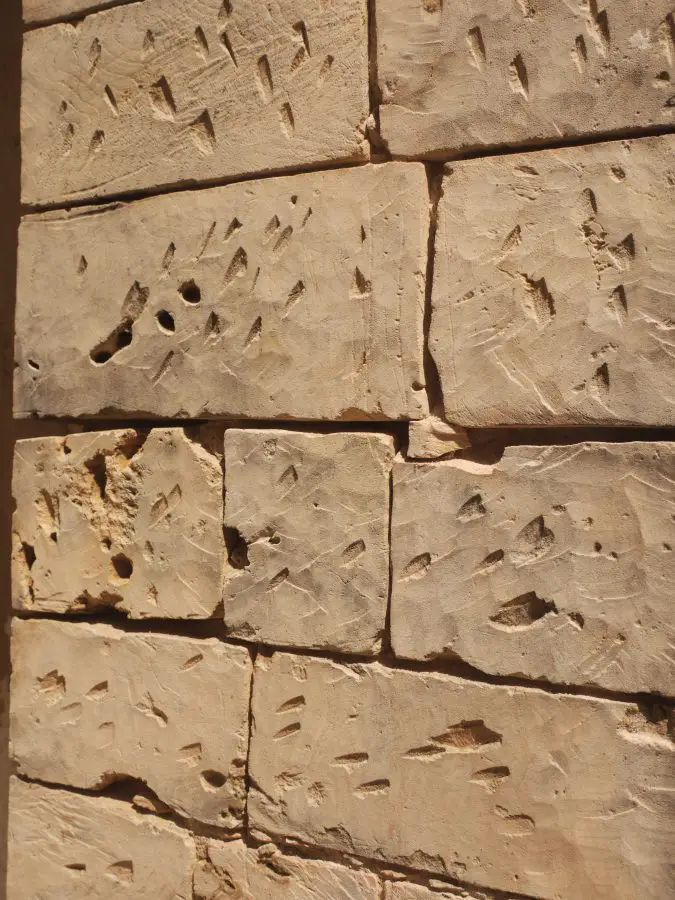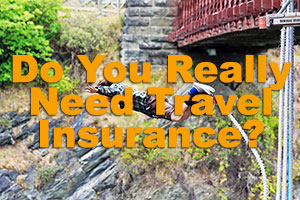Not too many people seem to make the journey to Jaffna at the northern tip of Sri Lanka which is a real shame. Since the civil war ended here in 2009, the local population, which almost halved during the troubles, has begun to return to live here once again. After we had left Jaffna and returned south many tourists and locals alike were surprised we had gone there and said they would wait another few years before visiting but truth be told now is the time to visit Jaffna while tourism is low, nobody’s out to make a quick buck and the locals are some of the most genuine people we met in our ten weeks in the country.

Devestated by fighting, this is the ruined shell of the former Kacheri (governement buildings), Jaffna
Reaching Jaffna requires a stopover in the busy town of Vavuniya, which was once known as Tigerland due to the strong presence of the LTTE (Liberation Tigers of Tamil Eelam) in the region. Much of the road side is still littered with mines and from the speeding bus you can see soldiers walking though the long grass working on clearing the area. Pulling off the main road at a military checkpoint we were ushered off the bus for a very simple passport check, we filled out a form, they took a copy of our passports and we were back on the road to Jaffna whizzing along the A9 spotting peacocks from the window.
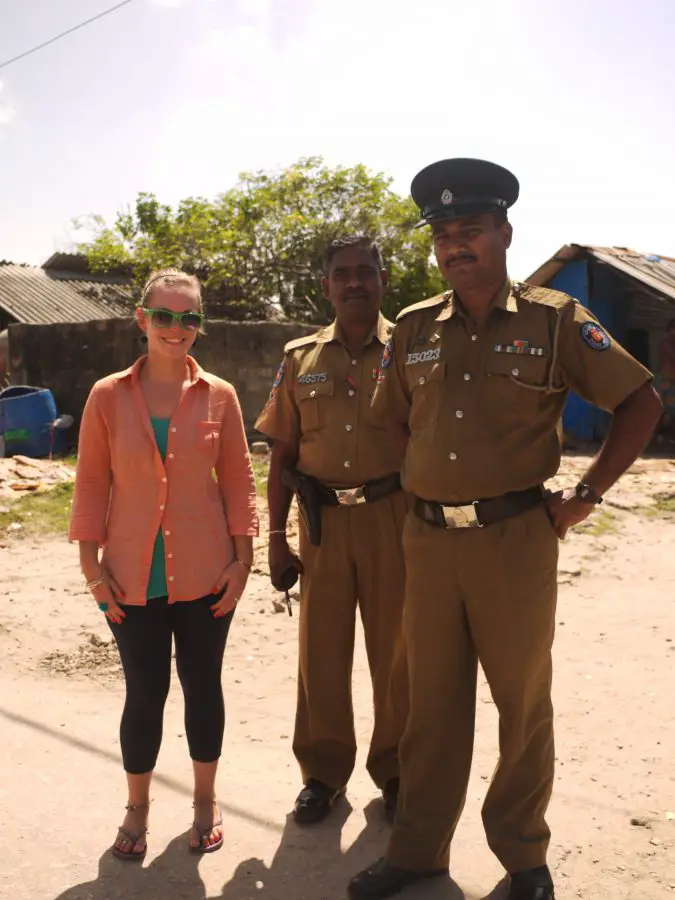
Wandering around the devastated community at Beach Road, these policemen approached us just to have their picture taken and have a chat.
Four hours later we pulled into Jaffna and immediately felt at ease when three tuk-tuk drivers waiting at the bus stop didn’t even bother to ask us “you need tuk-tuk?”, fantastic! With our guest-house only around the corner, we walked the few metres, checked in and headed out for dinner passing crumbling, ruined buildings as we went which had an eerie feel to them as dusk settled in.
Our first morning in Jaffna, we rented bikes which honestly could have been left here by the British when they left in the late 1940’s. Sitting high on our old-school bicycles we set out exploring the city and it’s history. Starting at the former Kacheri (government buildings), we parked up our bikes and went inside the ruins of the former headquarters. Trees were intertwined with the brickwork and only a bare husk of the building was left with every wall riddled with bullet holes from the fighting which took place here. With such a recent history this theme continued throughout our stay in Jaffna and it was a totally different and much more ‘real’ experience than visiting older battle grounds such as the Normandy beaches, the sites of the D-Day landings in World War II.
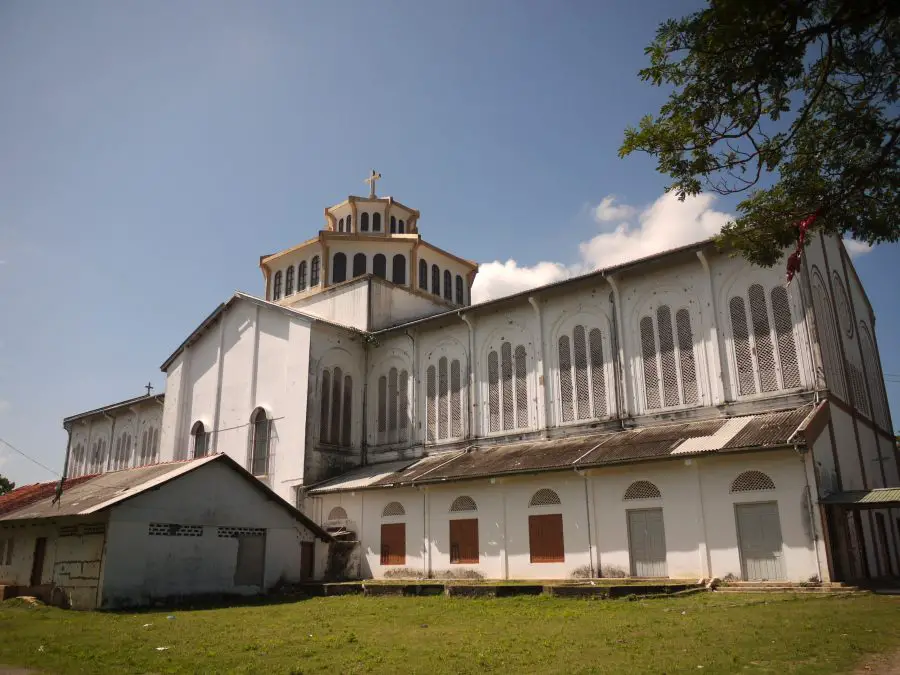
St. Mary’s Cathedral with it’s corrugated iron roof is enormous both inside and out. You can clearly see the marks which bullets left during the fighting on the top right of the wall facing you in this picture.
Christianity was introduced quite forcefully here by the Portuguese in 1620 as they demolished Hindu temples and mass conversion followed. Taking some time on our way to visit a few of the city’s churches was certainly worthwhile, especially as children were leaving school and were giddy at the sights of two foreigners pedalling by on antique bikes.
Beach Road, where much of Jaffna’s fishing industry is located, was hit hard by fighting between the LTTE and the Sri Lankan army and the evidence is stronger here than in any other part of Jaffna which we visited. A poor fishing community lives here amongst the rubble, in homes patched up with pieces of wrecked boats and galvanised sheeting, surrounded by thousands of fish left out to dry, but the people we met along this stretch, camera happy police officers included, smiled and waved as we walked through their little community.Young kids approached us, mad to have their picture taken, elderly men and women scaled and gutted fish sheltered from the midday sun, teenagers all wanted to say hello. Goats, puppies and kittens hung out in the quiet, narrow streets lined by houses painted in bright colours. Moving into the centre of town we grabbed some lunch, strolled around the busy market and visited a mosque where we were given quite an intensive introduction to Islam and even offered an English version of the Quran as we were leaving but with little room in our bags we had to politely decline.
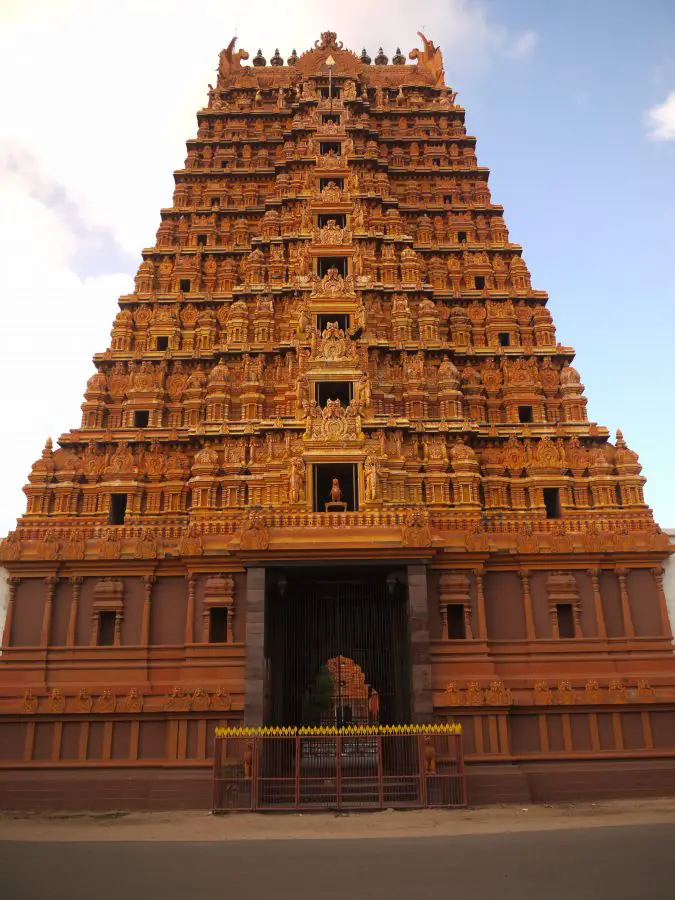
This fantastic Gopuram is one of the entrances to the Nallur Kandaswamy Kovil, Jaffna’s premier Kovil.
Moving from Islam to Hinduism we sought out Jaffna’s premier Kovil (Hindu temple), Nallur Kandaswamy Kovil to the north of town. Rivaling some temples we had seen in India the temple was a magnificent sight, towering up from the ground the two main rainbow coloured gopurams were intricately decorated with Hindu Gods and mythological creatures, topped with a golden ochre. Inside the temple we joined the small crowd performing puja (prayers), circling the central deity and stopping at each of the smaller shrines as we went. Much more relaxed than the kovils of southern India due to much less people, it was the perfect way to spend some time unwinding after a day of negotiating Jaffna’s dusty roads, many of which were still under construction.
Connected by a series of bridges, the islands off Jaffna’s west point were to be our next stop and another Kovil was the main reason for coming out here. Bouncing along for an hour and thirty minutes as far as we could by road, we passed through the flat savannah-like landscape of Velanai and Kurikadduwan islands. More devastation was evident here, with debris of buildings and pocket-marked palm trees lining the roadside as we passed. Reaching the port we were ushered onto basic wooden ‘ferries’, run by the navy, and we began the journey to remote Nainativu to the sound of the
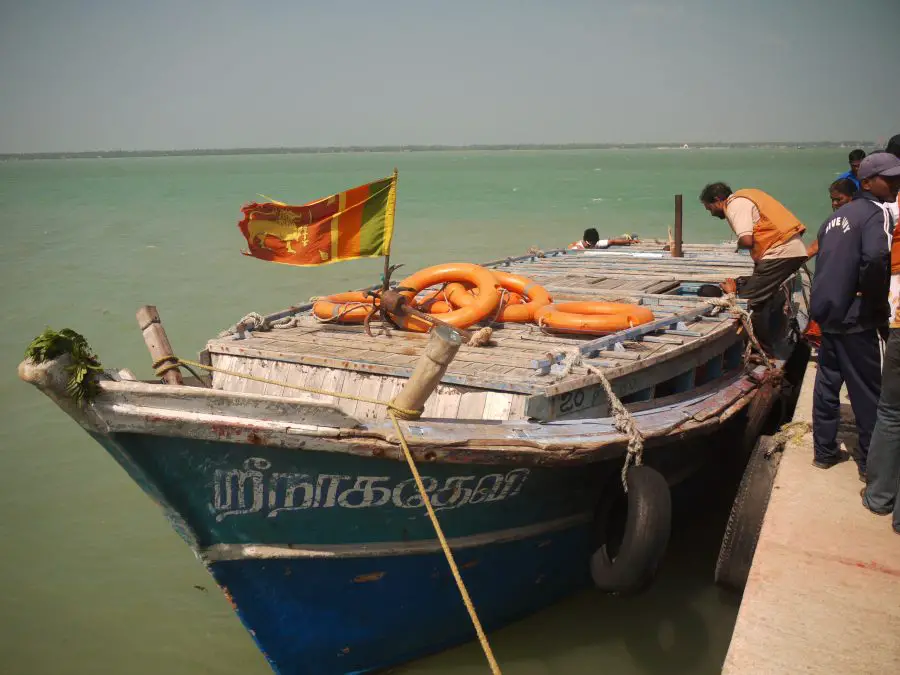
This simple boat, operated by the Sri Lankan Navy is the ‘ferry’ to remote Nainativu Island west of Jaffna.
chugging engine at our feet. Getting closer to the island, the Tamil style Hindu temple dominated the shoreline and it’s colourful towers jutted majestically skyward from the sands. Walking around the peaceful and incredibly colourful interior of the temple was almost a divine experience, Brahmin priests performing pujas and reverent locals circling the inner sanctum of the temple, holding their hands together and kneeling to touch their foreheads off the floor as they passed each of the Hindu gods. Further down the shoreline, northern Sri Lanka’s only major Buddhist pilgrimage site is set on the coastline here and is where most of the other passengers, all dressed in white, from our ferry were destined. An unusual silver dagoba is the main feature here and stood as a major contrast to the fantastic blue skies the day we visited.
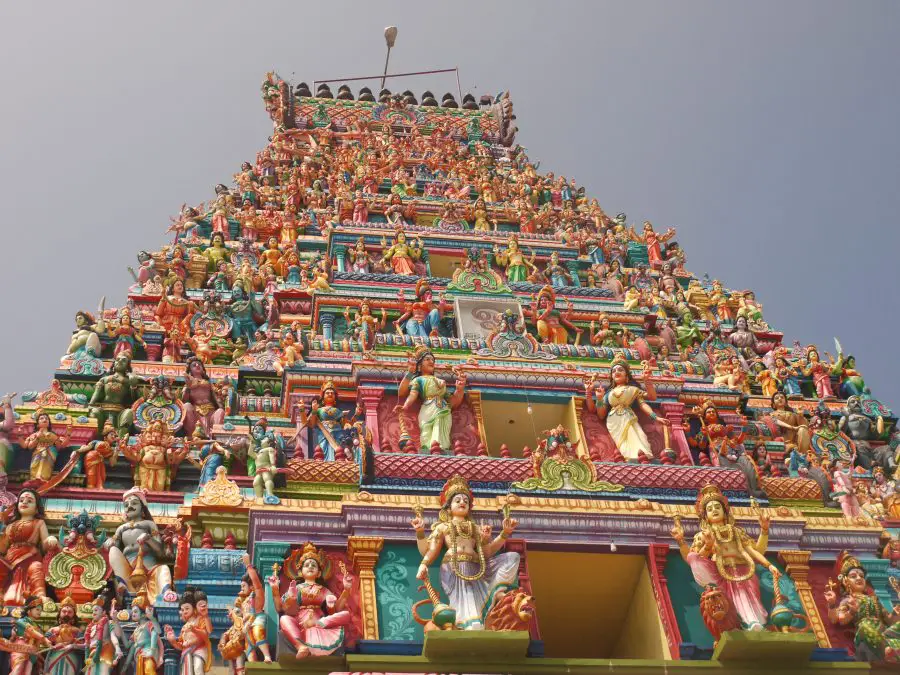
The colourful and so impressive Nainativu Nagapooshani Amman Temple, on the remote Nainativu Island off Jaffna. It’s a Tamil style Hindu temple similar to those found in Southern India.
Reaching Jaffna town mid afternoon we decided to utilise our time and hop on another one hour bus to the peninsulas north of Jaffna, some the country’s most northerly points. Passing even more buildings which suffered the devastation of war we finally reached the end of the road and there was only a handful of locals and a few soldiers here.
Vines hung from the trees, strong enough to swing off, the beach had a barbed wire fence running along it’s sands and a wrecked boat, half-submerged, lay just offshore. A sacred spring marks the end of the Kankesanturai Peninsula, where seawater flows into a large pool and locals bathe to rid themselves of any ailments however on this day we were the only ones there adding to the incredibly isolated feel in the far northern reaches of this area.
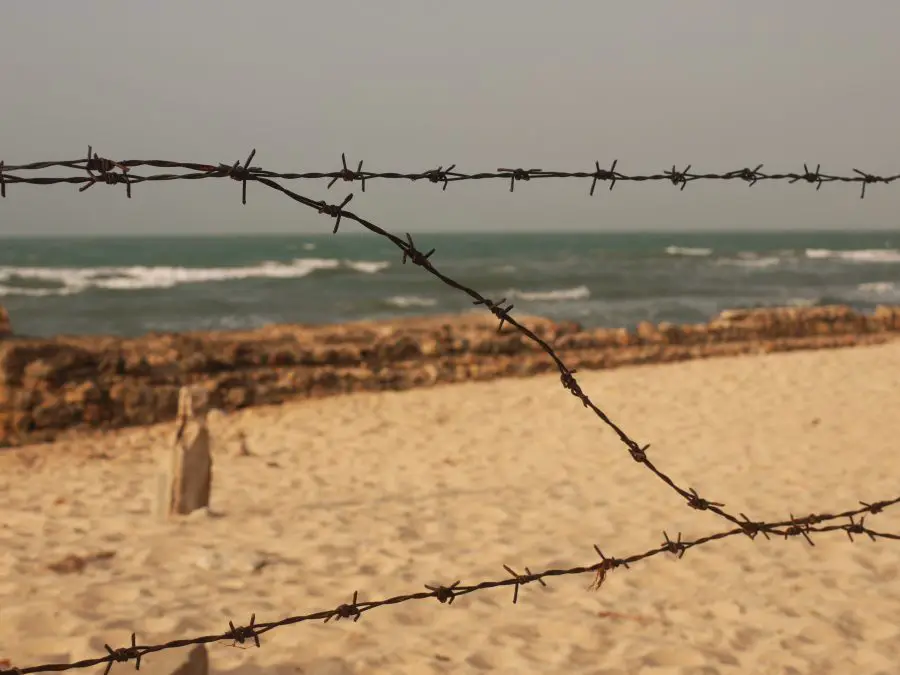
Barbed Wire still runs along the beaches at the tip of the Kankesanturai Peninsula in a still heavily militarised area.
The remains of an old Hindu temple were succumbing to the overgrowth as we walked back to the bus stand just in time for the last bus back to Jaffna, but some statues and faint frescoes remained on what was left of the walls. Just next door a new temple is under construction for the last number of years and is as beautiful as any we saw in southern India or in Jaffna’s centre. This image alone, the sight of a ruined temple lying in the shadows of a brand new, impressive and impossibly colourful temple sums up what Jaffna is all about, a place of contrasts, which has been through so much but coming out the other side more positive than ever before.

Brian is a travel writer, photographer, blogger, travel addict and adventure-junkie. Being outdoors, getting off the beaten track and outside his comfort zone is what makes him tick. Brian’s the dreamer in the relationship; when he’s not travelling, he’s dreaming about it! Keeping fit, cooking, music and red wine take up the rest of his time.
Sign up for our free travel photography Ebook "Faces of Nepal" and you'll also receive our monthly newsletter.

